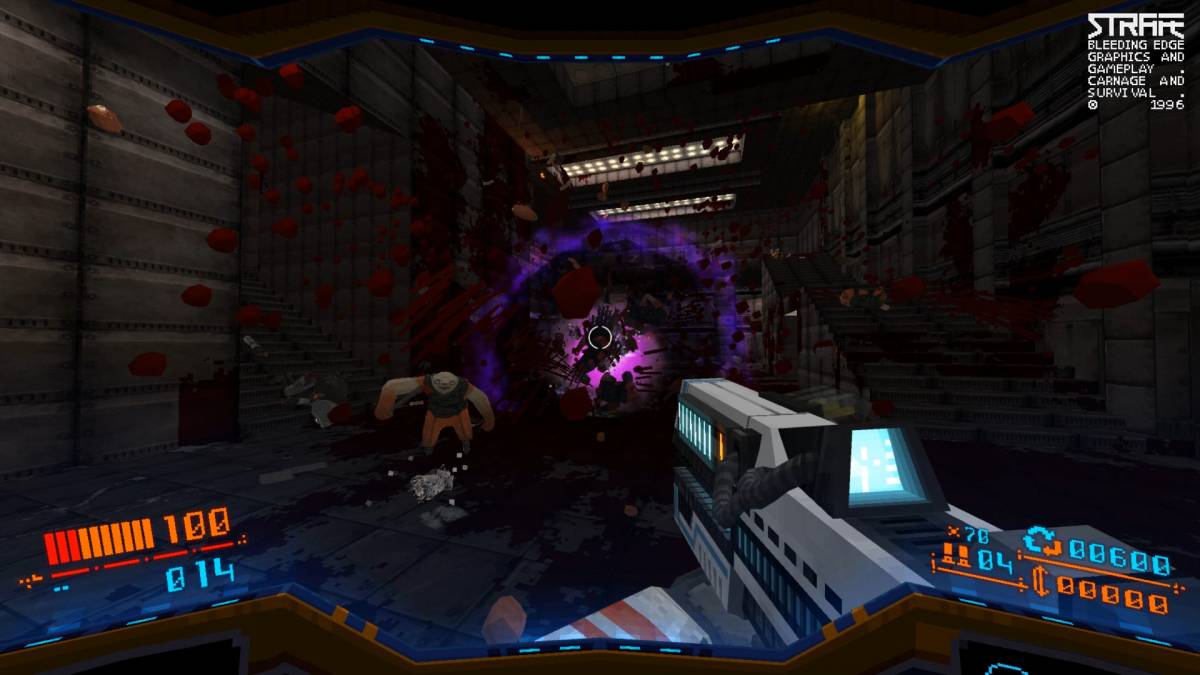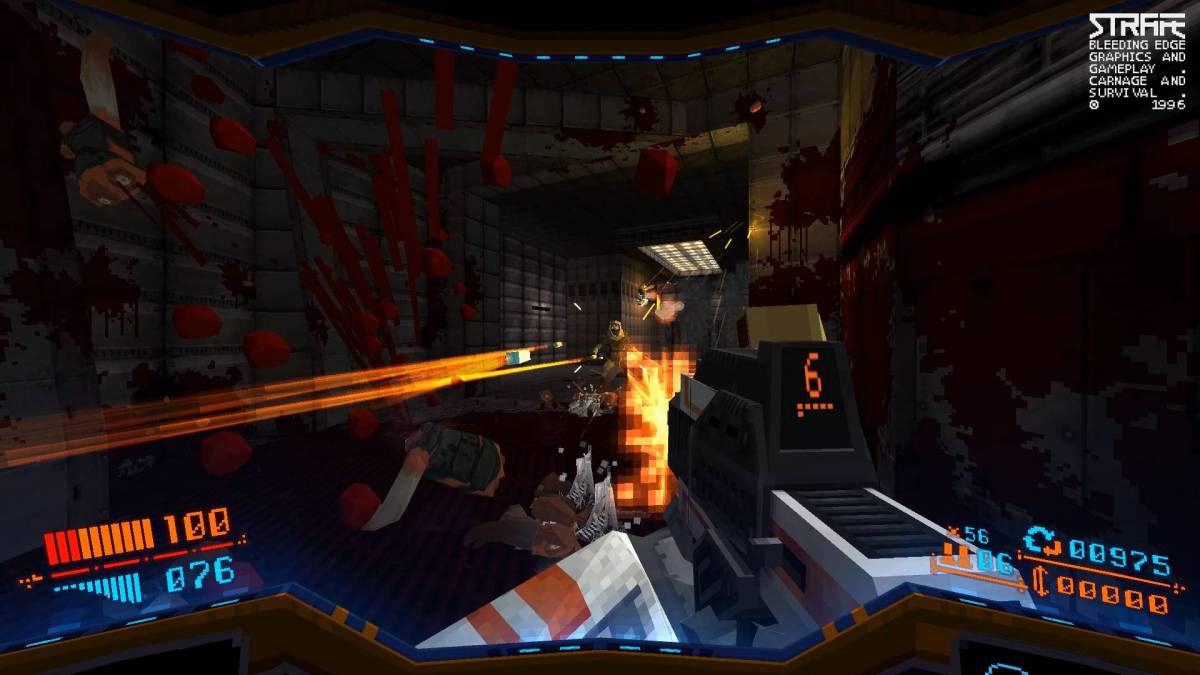First impressions mattered a lot in retro first person shooters. Anyone who has ever played DOOM remembers walking into the first room of E1M1. The stairs that led to glowing green armor on the left, the switch hidden behind a pillar, and the window looking over a lovely nukage lake. A sense of mystery is made through that rooms use of environment. Players want to explore because the first few steps are already laced with secrets for them to uncover. STRAFE’s biggest issue is that it starts out its gameplay with a zone that does not show what the game is capable of. STRAFE is another indie game that was funded on Kickstarter a few years ago, and after delays and some very strong trailers for the game it is finally here to a lukewarm reception.
STRAFE uses procedural generation to randomize the layout of its areas each time its played. This is not fully random, but rather uses a method where rooms are prebuilt and then their layouts are wildly different each playthrough. This was a smart choice since it avoids the issues a lot of fully randomly generated games have where the layouts of levels all have a distinct lack of design. STRAFE does have this issue with its first zone, Icarus. Icarus is a giant spaceship that the player is sent to in order to collect scrap. The story does not evolve much from there and is just a means to get a gun in a player’s hands.
Icarus has the most confined level design of the four zones, the least enemy variety, and has the most repetitious environments. The amount of times you will see the homage to E1M1 of DOOM will have you predicting which way to bunny hop out of there as soon as possible. Icarus feels too cramped and limits the player’s ability to use speed and maneuvering that was so vital to survival in DOOM and Quake.

The narrow hallways filled with fire that does way too much damage and blocks the path forward and acid forces the player to be methodical in their approach to this zone. Instead of bunny hopping around with a railgun as some sort of hyper avatar of destruction, the player pauses to shoot enemies that are waiting to drop down from the roof or fall back to a chokepoint to exploit the rather dull AI.
But the pains of Icarus do not have to be felt for long. As in many “rougelites” there is a way have permanent progression in STRAFE. During the intermission between level two and three of a zone you are able to buy a teleporter part which can be used to fix a teleporter at the end of the zone. Once both parts have been installed that section can be skipped for the rest of the playthroughs. After geting the ability to skip Icarus I never played through that section again.
After Icarus is when the game opens up and allows the player to use mobility in a way that had been limited before. The caves are multi level and have sprawling open air parts. A new variety of enemy is added in the form of a giant rock monster that is very fast and capable of just keeping up with the player’s speed unless they’;re bunnyhopping. While an enemy with this sort of mobility would have been an issue in the cramped corridors of Icarus, the player is now expected to move through the level quickly and efficiently. Mobility helps this game feel much better.

STRAFE’s rougelite traits also include two types of currency to keep track of, scrap and credits. Scrap is found in crates (here’s something I didn’t realize until about ten hours in, keep shooting the boxes until they’re empty!), robotic enemies, and randomly scattered throughout levels. In each level there are machines where scrap can be turned into ammo or armor. Though some should be saved because scrap can also be turned into the second currency, credits. Credits are found on dead enemies or bought with scrap at a shop. Credits are how players buy items in the game’s stores.
With those few traits of rougelikes STRAFE fails to capitalize on the strengths of that genre. One of the biggest missed opportunities is the lack of a buildable class. Instead the player chooses between three starting weapons: a machine gun, shotgun, and railgun. Though other weapons can be found, they are unable to reloaded which gives them that age old issue of “I’ll hold onto this until I really need it”. The shotgun and machinegun feel anemic to the point where they feel ineffective against more than a couple enemies at a time.
The railgun is the only starting weapon that typically hits for an instant kill, but its initial slow rate of fire make it tricky to use until it’s upgraded by components found in level. The three main weapons can be upgraded and changed throughout play. Their base stats of damage, accuracy, magazine size, and shooting speed can be increased through picking up cores that are hidden in small crates. These are absolutely essential to fixing the issues of the weapons.

Weapons can also have their primary fire and secondary fired change through helpful robots that take your weapon for a short time to upgrade them, though it’s frustrating to give a powerful weapon type to the machine and get handed back something that is much weaker. A lot of the systems in STRAFE do not properly communicate to the player what the effect will be. While in rougelikes this makes for a fun gamble on whether the red poiton will heal or turn the player in a quivering stack of flesh, in a game that is trying to be an homage to the fast paced killing sprees of 90’s shooters it directly impacts how fun the game is to play.
Pixel Titans is aware of the issues the game has and since its release they have put out two patches that addressed the issues with limited health in Icarus, the weak weapon sounds, and intense fall damage. STRAFE’s issues are mostly things that just require a few tweaks: put in ambient enemy noises so the player knows when enemies are around, adjust the level generation of Icarus, and remove some of the obfuscation of information about upgrades, and the game will be considerably better to play.
The core gameplay of running through fun levels while causing as much gore as possible is very rewarding, especially with a backing soundtrack that pushes the player to kill more. But the little things do add up over time to detract from the flow of the game. As it stands, I can only recommend STRAFE after a few more patches or when it’s on sale for under $10.
Copy purchased
Some of the coverage you find on Cultured Vultures contains affiliate links, which provide us with small commissions based on purchases made from visiting our site.

